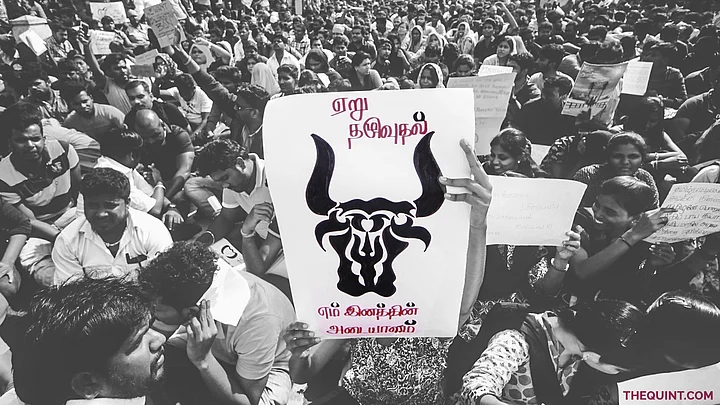They are not being led but are leading themselves. They have maintained a fair distance from the current crop of netas (hope politicians are taking note of that) and have not allowed themselves to be tied down to parties-affiliated students’ unions.
Should the upsurge of young Indians we are witnessing on the issue of Jallikattu be construed as their anger with liberalism?
This may be a wrong reading of the protests spreading from Marina beach to remote parts of Tamil Nadu. The aspiring youth of this country, with no jobs and very little visible opportunities, may just be using this trigger to make a larger point.
Besides general joblessness, Tamil Nadu is reeling under severe drought and the hyper-emotional people of the state are grappling with a political vacuum after Jayalalithaa's death. The current political transition in the AIADMK and the DMK, the two parties that have ruled the state for close to five decades, is an unsettling issue for them.
What Is the Youth Trying to Say?
- Upsurge of young Indians on the issue of Jallikattu shouldn’t be construed as their anger with liberalism
- The aspiring youth of this country, with no jobs and very little visible opportunities, may just be using this trigger to make a larger point
- With Modi’s consistent popularity, what is at test going forward is this – Is India becoming more liberal or conservative?
- A strong Modi represents a nationalistic idea which does not acknowledge sub-nationalistic aspirations
- A new thought is required to not “accommodate” but respect this sub-nationalistic tendency
Drawing Parallels With the Patidar, Maratha Protests
The unprecedented Maratha protests of last year got ignited by a rape case but it made the larger point of rural distress and unemployment. Both these protests are spontaneous and leaderless and yet totally peaceful. The Patidar movement may have some political colour to it but the underlying theme is same – social unrest.
And this social unrest is a direct result of jobless (slow) growth and an uncertain future. The future generation of the nation with the largest population of the youth in the world knows that if pressure is not mounted soon on the political class, the demographic dividend may be squandered.
Those who are using Jallikattu protests to ridicule the of idea of a liberal India and seeking validation by referring to the Trump phenomena and Brexit and other conservative trends in some parts of Europe as evidence of the changing mood of India, are perhaps jumping the gun and drawing hasty conclusions.
Indians are politically very astute. Their perceived silence (for instance on the issue of demonetisation) and vociferous protests are pregnant with meanings that are hard to comprehend in traditional ways. We have seen that in the past – in elections after elections, the poor Indian voter has proved political theories and predictions of pundits wrong.
Is India Becoming More Liberal or Conservative?
In the current context this is a highly debatable issue – is India also seeing the same global trend of neo-conservatism, isolationism and anti-globalisation? This has become a talking point across the globe.
The Modi victory of 2014 is being cited as evidence of the changed mood of the people. But let us not forget that the stunning Modi victory became possible because of liberal voters, who believed that despite belonging to the BJP, Modi himself is a liberal moderniser.
Modi’s additional support base should not be confused with the traditional supporters. With Modi’s consistent popularity, what is at test going forward is this – Is India becoming more liberal or conservative?
The Tamil Nadu and Maharashtra protests remind us of a strong and continuing assertion of sub-nationalism. Of late, we are not discussing this undercurrent in India enough, but it is real and it is a work in progress.
The split of Andhra Pradesh and the Jat agitation should also be examined in this light. And watch Uttar Pradesh! This is one state that has been lagging behind in re-inventing itself.
Respect Sub-National Sentiments
We do not know what the political outcome of the UP polls is going to be. But somewhere, Akhilesh Yadav is trying to do what some state satraps have done in southern states in the past and Mayawati did not so long ago – taking the narrative of caste identity to a new level.
Akhilesh's campaign doesn't say this openly but he may be tapping the same sentiment of sub-nationalism. UP is the youngest geography in the world and we all believe that a young UP has moved beyond caste considerations alone. Modi’s performance in UP in 2014 also demonstrated this.
But a strong Modi represents a nationalistic idea which does not acknowledge sub-nationalistic aspirations. Dravid minds and hearts are saying exactly that today.
A new thinking is required that does not “accommodate” but respects this sub-nationalistic tendency and aspirations that makes India what it is today.
Also Read: Humans of Jallikattu Protests
(At The Quint, we question everything. Play an active role in shaping our journalism by becoming a member today.)
